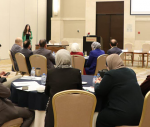You are here
The collapse of the Geneva talks
Feb 09,2016 - Last updated at Feb 09,2016
Not many observers were surprised by the quick collapse of the Syria peace talks last week.
It would have been a bigger surprise if the Geneva talks, organised by UN special representative Staffan de Mistura, had lasted any longer, let alone accomplished anything promising.
No adequate preparation, no substantive terms of reference, no preparatory understandings and lack of political will, are some of the reasons analysts circulated for the failure.
The idea had been to engage the various parties, with the direct involvement of Russia and the US, in talks that could last for months.
The hope had been to reach an initial ceasefire and agreements to end blockades and allow food into besieged areas, which could have then created an environment for more serious negotiations on the future of Syria.
It was clear from the beginning that the plan was too vague, ambitious and risky, but in the absence of any realistic alternative, its proponents argued that it was worth trying.
With the situation in Syria deteriorating fast, generating greater humanitarian tragedies and waves of refugees, and with terrorists said to have been radicalised in Syria striking in different countries, something had to be done.
The Geneva talks were that undaunted, de Mistura set a new date for talks to resume, before the end of February, but the prospects seem to be no better.
Commentators offered many theories about the situation in Syria and its geopolitical significance, but the key factor has been the dynamic of military confrontation on the ground.
Syria’s government had been losing ground to armed groups, many lavishly financed by regional states, but in recent months, the government, backed by the massive Russian military intervention, has been advancing.
Many believe that what is happening is part of a grand plan of regional and major world powers to undo the Sykes-Picot agreement of a century ago and draw new lines and spheres of influence.
Some have even likened US Secretary of State John Kerry and his Russian counterpart Sergei Lavrov to a new Sykes-Picot duo.
Much of this may be fantasy and speculation, but there is no doubt that Syria, along with Iran and Iraq, were on the regime-change hit list of US and Israeli neoconservatives since the 1990s.
When the neoconservatives took power, during the George W. Bush administration, they saw the 2003 US-led invasion of Iraq as the first stage in a plan to remake the region.
But things did not go as they had planned. Instead of turning Iraq into a model US client state at peace with Israel, they unleashed a regional disaster and massive instability.
In the eyes of many, they helped swing the balance of power towards Iran, which gained decisive influence in both Iraq and Syria.
Based on fears of Iran, some regional powers sought to create a “Sunni Arab” counter-alliance — and that logic lies behind much of what we see happening in Syria.
So what is happening in Syria is not part of some grand plan, but at best the result of a grand plan gone disastrously wrong from the perspective of its authors.
This, however, cannot take away from the responsibility of the Syrian government, which reacted with swift and brutal violence to protests calling for legitimate reform, in the context of the uprisings that swept the region in 2011.
The violent reaction and failure to appropriately handle legitimate political demands opened the country for a number of foreign forces, from the region and beyond, to fiercely fight each other in pursuit of their interests.
Since the crisis in Syria started, the dynamics have swung wildly. At first it was believed that the fall of the government of President Bashar Assad was inevitable.
Then came the view that there was no military solution for the crisis: there must be a political one.
Much time was wasted on whether any political settlement would leave room for Assad in a reformed Syria, with many concerned powers and the militias they sponsored insisting that Assad should go.
Soon after, priorities changed again with the rise of Daesh and other terrorist organisations that loomed as a threat far beyond Syria’s borders.
At that point, in the eyes of some, Assad became the lesser evil, if not an outright ally.
As the situation stands now, two sides are confronting each other on the battlefield: Russia, Iran and Hizbollah are fighting on the side of the Syrian regime against assorted armed groups, including some affiliated with Al Qaeda, supported by several Arab states, Turkey and the United States.
Both sides are claiming that their intention is to defeat terrorism, with Daesh proclaimed as a common enemy.
The Russian-Iranian camp wants to defeat the terrorists to rescue the regime, while the other side wants to defeat the regime with the forces fighting on its side.
The other complication is that while both sides agree on fighting the terrorists, they sharply disagree on who the terrorists are. Each considers any group fighting on the other side to be terrorist.
As the Syrian army, with the help of its allies, is making substantial advances, Saudi Arabia and the United Arab Emirates are talking about sending in ground troops.
While this may be under the pretext of fighting Daesh, their main concern is likely to prevent an opposition defeat.
The only guarantee, it seems, is that the war will go on and the situation for millions of Syrians, and across the region, will get worse before it gets better.
Let us hope the war will not be fed and escalated. The search for a political settlement should be intensified if the disaster in Syria is to be checked.













